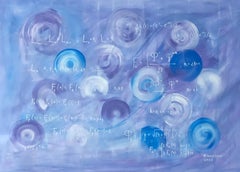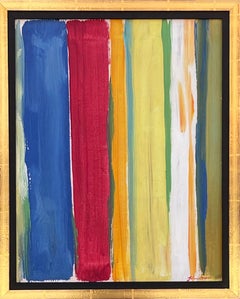Color-Field Interior Paintings
Recent Sales
Peace and Harmony, Science Art
Located in Sempach, LU
This extra-large artwork is made with mixed media: acrylic, markers, and oil pastel. Full size of canvas: 160x115cm; The painting area is 150x100cm. The painting is sent in the ROLLED form in a tube, which is safe for large canvases.
UV-protection varnish. Signed on the front- and back.
The artist uses mathematical formulas of Harmony rules.
Shipping worldwide in a safe package with a certificate of authenticity.
Anastasia Vasilyeva...
Category
2010s Color-Field Interior Paintings
Materials
Oil Pastel, Cotton Canvas, Acrylic, Permanent Marker, Engraving
Untitled abstract blue, red & yellow oil painting, New York artist
By John Opper
Located in Beachwood, OH
John Opper (American, 1908-1994)
Untitled
Oil on canvas
Signed lower right
20 x 16 inches
22.25 x 18.25 inches, framed
John Opper described the 1930s as a "great gestation period" for his art. "I thought the Thirties was a very vital time for American art. . . . With the WPA, you got together whether it was the [Artists'] Union or the [American Artists'] Congress or whether it was a bar. . . and you talked about art, and you heard about important artists, and you began to live art." But Opper also remembered the thirties as a period of breakdown in the vitality of American art; "we became aware that a great deal was missing."
Academically trained like many of his contemporaries, Opper came to New York in 1934, two years after his graduation from Case Western Reserve University in Cleveland, Ohio. As a youth, he had taken Saturday art classes at the Cleveland Museum of Art and later studied at the Cleveland School of Art and the School of the Art Institute of Chicago. When he arrived in New York he was a well-trained painter, adept at rendering still lifes and particularly landscapes depicting the American scene. A reviewer of his 1937 exhibition at the Artists' Gallery in New York, for example, wrote about Opper's "colloquial flavor … spontaneity and an imaginative use of color which conveys just the feeling" that the subjects—East River tugboats, old garages, and scenes around Manhattan— suggested.
By 1937 Opper had become familiar with modernism, though he was not yet converted to the cause. Indeed, his 1937 show was made up of the still popular regionalist paintings. Earlier, in 1935 and 1936, he studied with Hans Hofmann and began to think in terms of forces and tensions within the picture plane. He met Wilfrid Zogbaum, Giorgio Cavallon, Byron Browne, Rosalind Bengelsdorf, and George McNeil, with whom he shared a studio. He paid frequent visits to Gallatin's Gallery of Living Art. He joined the WPA easel project in 1936 and began to paint in "a kind of transformed cubist style."
When war came, Opper worked for three years with a marine architectural firm making drawings for the pipe systems of PT boats...
Category
Mid-20th Century Color-Field Interior Paintings
Materials
Oil

